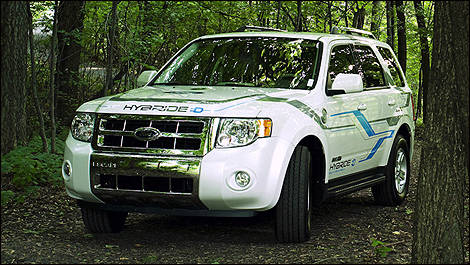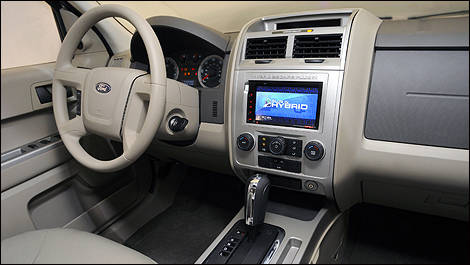Who on Earth actually looks forward to getting stuck in downtown traffic? Probably anyone driving a Ford Escape Plug-In Hybrid, the only operational vehicle of its kind currently found in Canada. Why is it so? Well, the very nature of this SUV makes it equally pleasant in the city and on the countryside. More importantly, though, low-speed driving becomes a wonderfully-refined, totally-silent experience.
The basics on plug-in-hybrids
The Ford Escape Plug-In Hybrid is basically just a regular hybrid -- and a regular Escape for that matter. There’s not much physical difference aside from the temporary stickers… and obviously the small outlet on the left side to plug the recharge cable into.
The interior is also very similar to the traditional Escape, except for the control monitor right in the middle of the center stack. It’s actually a communication interface providing information to the driver on all sorts of vehicle functions, including audio and climate control, as well as fuel economy and battery usage.
In reality, the Ford Escape Plug-In Hybrid merely adds a couple of lithium-ion batteries that can be charged directly from any power outlet at home or at work. A full charge takes about 6 to 8 hours and allows a range of 48 kilometres in optimum conditions.
When the battery pack runs empty, this Escape turns into a conventional hybrid, meaning it combines gasoline and electricity to move the vehicle and uses a regenerative braking system to charge the batteries on the go.
Under the hood is the same compact four-cylinder that motivates the regular Ford Escape Hybrid. However, a number of upgrades have been made to boost safety and driveability. For instance, the brakes are more powerful and the chassis is stiffer in order to make up for the added weight of the new hardware, including the batteries and integrated cooling system located in the rear under-floor compartment. And let’s not overlook the fact that the HVAC unit has been considerably revised to reduce the load on the battery pack.
 |
| We still don’t know how the new Ford Escape Plug-In Hybrid will be priced upon its 2012 market release. |
The basics on plug-in-hybrids
The Ford Escape Plug-In Hybrid is basically just a regular hybrid -- and a regular Escape for that matter. There’s not much physical difference aside from the temporary stickers… and obviously the small outlet on the left side to plug the recharge cable into.
The interior is also very similar to the traditional Escape, except for the control monitor right in the middle of the center stack. It’s actually a communication interface providing information to the driver on all sorts of vehicle functions, including audio and climate control, as well as fuel economy and battery usage.
In reality, the Ford Escape Plug-In Hybrid merely adds a couple of lithium-ion batteries that can be charged directly from any power outlet at home or at work. A full charge takes about 6 to 8 hours and allows a range of 48 kilometres in optimum conditions.
When the battery pack runs empty, this Escape turns into a conventional hybrid, meaning it combines gasoline and electricity to move the vehicle and uses a regenerative braking system to charge the batteries on the go.
Under the hood is the same compact four-cylinder that motivates the regular Ford Escape Hybrid. However, a number of upgrades have been made to boost safety and driveability. For instance, the brakes are more powerful and the chassis is stiffer in order to make up for the added weight of the new hardware, including the batteries and integrated cooling system located in the rear under-floor compartment. And let’s not overlook the fact that the HVAC unit has been considerably revised to reduce the load on the battery pack.
 |
| The control monitor right in the middle is a communication interface providing information to the driver on all sorts of vehicle functions. |


